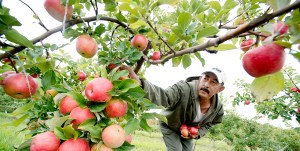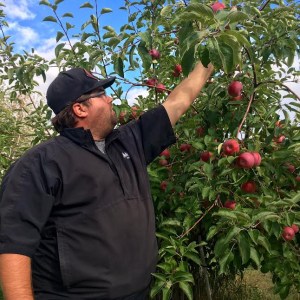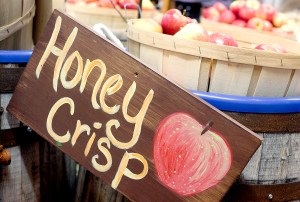LEWISTON — Apple orchard farmer Nick Benoit hears a lot of requests for the Honeycrisp apple.
“People coming in asking for it every day,” Benoit said Saturday. “They’re one of the best-selling apples,” he said, even though his Honeycrisps cost $2.49 a pound, the McIntosh and Cortlands $1.10 a pound.
“And our Honeycrisps came out great this year,” he added.
Move over McIntosh, Pink Lady, Fuji and Granny Smith. In the apple world, the Honeycrisp is a rising star.
Wildly popular with consumers nationwide, Maine growers are scrambling to grow more Honeycrisp apples each year, despite the fact they’re high maintenance, hence the higher price.
Harry Ricker of Ricker Hill Orchards in Turner has invested heavily in the Honeycrisp, a bet that’s paying off.
“Honeycrisp is the only reason we’re in business,” he said. “McIntosh and Cortland don’t pay the bills anymore.”
Boothby’s Orchard and Farm’s website begins with the words, “Your Honeycrisp are ready.”
“They’re very popular, said sixth-generation farmer Robert Boothby of Livermore. “It has a great combination of flavor, a unique, great texture.”
They’re sweet and tart and oh so crisp, he said.
Sue Cooper of Cooper Farms in West Paris said the Honeycrisp is in demand for their taste and because they store well.
“They don’t break down,” she said.
Today, Honeycrisp apples make up between 10 to 20 percent of apples produced in Maine, compared to 16 years ago, when virtually no Maine orchards were selling Honeycrisps, said expert Renae Moran of Highmoor Farms, the University of Maine Cooperative Extension’s research station.
The apple’s popularity is good news for Maine, because Maine has an ideal climate of cooler summers for the variety, she said.
“Maine grows a better Honeycrisp than Pennsylvania or Washington state,” Moran said.
Eventually the Honeycrisp will replace the McIntosh as the No. 1 variety, Moran said. That’s big, considering the Mac has been the apple king in the Northeast since the 1930’s.
While the McIntosh and Cortland apples have done well, in recent decades, Maine’s missed out on national blockbusters, Ricker said.
In the ’70s and ’80s, apple growers across the country made a lot of money on the Granny Smith apple, as well as the Rayburn, Fuji and Pink Lady varieties.
“None of those grow in Maine,” Ricker said.
He explained that Maine only has 110 days of a frost-free growing season.
“That’s really short,” he said.
But it’s plenty for the Honeycrisp.
Ten years ago, “we mortgaged everything we had and grafted a whole bunch of Red Delicious, McIntosh over to Honeycrisp,” Ricker said.
His farm grew thousands of Honeycrisp trees.
Because it takes the trees about 10 years before they offer good yields, taking other trees off production made his banker nervous, Ricker said. As the farm waited for the Honeycrisps to ramp to full production, for several years, Ricker cut forest wood for revenue.
Three or four years ago, his Honeycrisps started bearing enough fruit to sell.
“Last year, we had a good crop — and just in time,” Ricker said. “We were running out of trees to cut. Now we’ve got 129 acres of Honeycrisp all starting to produce. We took a gamble that people would still want them.”
Last year, Ricker Hill Orchards sold 200,000 bushels of all apples, including 33,000 bushels of Honeycrisps. This year, he’s expecting to boost Honeycrisp sales to 50,000 bushels.
The apple demands a higher price because it costs more to grow, Moran said.
“Their yield is not as good as the McIntosh,” Moran said. “They’re a finicky apple.” They need extra attention being fertilized, special storage and treatment after harvest.
Also, the apple has an aroma that attracts insects and animals which literally eat an orchard’s profits. Ricker’s seen whole flocks of turkeys eating his Honeycrisps off the trees.
Deer, porcupine and other critters also like to eat the buds, bark and fruit.
“Birds and bugs love them,” Moran said.
That means extra work for farmers to protect and bring the apples to harvest.
It’s worth it, Ricker said.
Chomping into a Honeycrisp “is the total eating experience,” he said. “It’s not mushy, not rock hard. The combination of the crunch and flavor makes it a special fruit.”
Apple season underway
Eat them — apples are really healthy (when not covered with sugar and shortening in pies). Multiple studies tout apples as among the healthiest foods; apples have fiber and important antioxidants, which can help reduce the risk of diseases such as diabetes, cancer, heart disease and hypertension.
Apple season in full-swing. As of Sept. 18, 44 percent of Maine’s apple crop has been harvested.
Maine orchards. The Maine Pomological Society lists 56 apple orchards in Maine. For a list with phone numbers and more information, visit www.maineapples.org/directory/index.php/orchards.
We’re an apple state. Maine’s apple acreage is 2,700, down from 3,100 in 2010, but the yield per acre has increased from 10,000 to 14,100 pounds. The value of apple sales in Maine has grown to over $17 million; Maine accounts for about 25 percent of production in New England.
Because of the drought, production in the Eastern states is expected to be down by 9 percent, or 2.26 billion pounds. (Those states include Connecticut, Maine, Maryland, Massachusetts, New Jersey, New York, North Carolina, Pennsylvania, Vermont, Virginia and West Virginia).
Only Maine is projected to increase production from 35.6 million pounds in 2015 to 42 million pounds in 2016. Despite the drought, Maine farmers say they have a good crop of apples this year, though some are smaller than normal.
Source: Maine Department of Agriculture



Comments are no longer available on this story